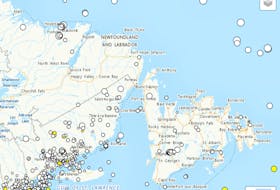A trio of employees of Nalcor Energy and its subsidiary Newfoundland and Labrador Hydro were on the stand at the Muskrat Falls Inquiry Wednesday, taking questions on forecasts and assumptions used in the lead-up to the Muskrat Falls hydroelectric project.
Paul Stratton, a senior market analyst, spoke about customer demand for power and the load forecasts he developed before the project’s sanctioning.
Bob Moulton, a system planning specialist with N.L. Hydro, spoke about power generation possible at facilities throughout the province, and the planning for the introduction of new sources of power.
Auburn Warren, Nalcor Energy’s general manager for commercial, treasury and risk, was asked about financing costs and the consideration of those costs, including interest during construction.
Many questions went to Stratton, focusing on the 50-year load forecast he developed, covering to 2067 — 50 years from the original Muskrat Falls in-service of 2017.
Stratton said he essentially developed a 20-year forecast first and then extrapolated beyond the 20-year mark, using what he considered conservative estimates for the elements included, including expected energy demand from homeowners. For that, he said the forecast beyond 20 years essentially assumed the province as it was in the 1990s — the years immediately following the cod moratorium, when a rise in power demand slowed as the economy lagged.
RELATED STORIES:
Questions for auditors wrap up at Muskrat Falls Inquiry
Nalcor demonstrates confidence in Muskrat Falls decision
In developing the forecast, he described inclusion of a “technological factor,” considering the potential for new technology and increased energy efficiency to significantly affect the local energy market. The idea was it accounted for sudden disruptions, like the introduction of new energy-efficient appliances, or the original recognition of the value of added insulation for homeowners.
That is different from the decision to try an approach of aggressive management of demand, through offering significantly increased incentives for home improvements, for example, or otherwise pressing energy efficiency at homes and businesses. Nalcor Energy made the decision those efforts couldn’t be relied on to keep energy demand and peaks in energy demand down enough over the long term to avoid the need to add new generation to the power grid.
Time was spent on the concept of price elasticity and the change in demand for power based on a rising price. It was not included in the forecast models. Stratton said that was essentially because the provincial system had not shown itself to respond significantly in that way, and any value he ascribed to it would have been a shot in the dark.
He noted some options for people to switch from electric heat, like natural gas, are not available in the province, and oil forecasts showed electricity would look better than home heating oil (to date, oil prices did not rise as expected at the time of Stratton’s load forecast).
Power rates were also, by original estimates for the Muskrat Falls project, not expected to move as significantly as they are now, with original estimates in the range of 15 or 16 cents per kilowatt hour on average, according to testimony, and construction overruns now suggesting much higher rates without mitigation efforts.
The concern of customers abandoning the system has recently been raised at the province’s Public Utilities Board, where the consumer advocate has submitted a related study from Memorial University of Newfoundland economist Jim Feehan, who is scheduled to appear as a witness later in the inquiry.
Ultimately, Stratton said he would not have approached his forecasting differently if given the chance to do it all over.
“I stand by my forecast,” he said.
The inquiry sat late Wednesday and completed time with the Nalcor panel and the planned work in Labrador. It returns to St. John’s to launch hearings there on Monday, with former premier Danny Williams set to be called to the witness stand.
Coming Up
Former premier Danny Williams is scheduled as the first witness when the inquiry moves to St. John’s Monday.
Next on the witness schedule (subject to change) is a panel to begin to address Indigenous consultation and related issues, with recall of president of the NunatuKavut Community Council, Todd Russell, Prote Poker representing the Innu Nation, and Aubrey Gover for the Government of Newfoundland and Labrador.
Carl McLean and Rodd Laing will appear on behalf of the Nunatsiavut Government, with Jean-Charles Piétacho, chief of Conseil des Innu de Ekuanitshit.
Change in Muskrat Falls costs
During testimony at the Muskrat Falls Inquiry Wednesday, it was noted estimates for the regular operating and maintenance costs for the project have changed again.
The annual costs were originally estimated at $34 million.
In 2017, after Stan Marshall took over as president and CEO of Nalcor Energy, he told reporters the costs had been updated, and instead stood at $109 million.
But as reported to the Public Utilities Board, and noted in testimony at the Inquiry on Wednesday, the most recent estimate is $85 million a year.
Both the $109-million estimate and, now, the $85-million estimate include about $9 million a year in additional environmental monitoring agreed to by Nalcor Energy after the project’s sanctioning.
The drop in the estimate from 2017 to now was the result of a detailed review of costs, including refining of the estimated labour costs, equipment demands and other related factors, filed with the PUB and likely to be subject to further questioning before the regulator and at the inquiry.
The regular operating and maintenance costs will come as the project comes online, with first power expected in 2019 and full power scheduled for the third quarter of 2020.









